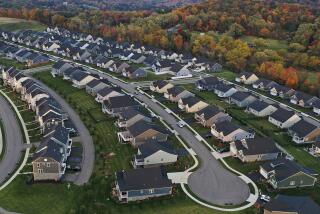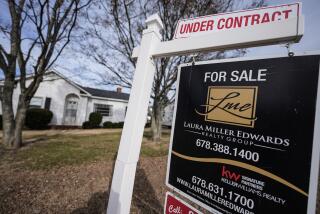Union Official Gets Rich in Housing Business--Without Making Money
- Share via
BOSTON — Tom McIntyre builds and sells houses at 40% below the going rate in Boston’s costly real estate market. And he goes out of his way to make sure that he does not make money on the deals.
Who is this man? Some kind of urban housing Robin Hood?
McIntyre is actually a 54-year-old, cigar-chomping, up-through-the-ranks union official, a vice president of the Bricklayers and Masons Union.
Four years ago, he set out to relieve the housing shortage that is pricing Boston neighborhoods beyond the reach of many who grew up in them. His solution was to build low-cost, not-for-profit town houses.
18 Units Completed
“We thought we could build affordable homes and have an impact on the total market,” McIntyre said in an interview at one of 18 completed units in the city’s South Boston section.
He would like to see his effort duplicated by construction unions elsewhere in the country.
“The beef is: If you are poor, you could get subsidies; if you’re rich, you don’t need them. These houses are for the $2 bettor,” he said.
While trying to preserve close-knit, working-class neighborhoods, he expressed another hope--that his homes would improve the image of organized labor.
“Unions have been painted as a self-interest group,” said McIntyre, who left school after the 10th grade to lay brick.
Course at Harvard
Ten years later, he became a full-time union officer. Displaying promise, he was selected 20 years ago for a union management course at the Harvard Business School.
“Our aim is to work on the grass-roots neighborhood level so that people begin to understand that unionism is a force for good in their community,” he said.
General construction, plumbing and electrical contractors for his projects are selected by the respective craft union and must pay union scale wages, McIntyre said. “The contractors are not hitting home runs, but they’re making a profit, and the home buyer gets a house 40% below market rate.”
Such a saving is significant. In greater Boston, the seventh-largest U.S. metropolitan area, the average home now sells for about $150,000, second-highest in the nation, the National Assn. of Realtors says.
‘Zero Overhead’
The savings are made on development costs, he explained. Nothing is passed on to the buyer because the Bricklayers and Laborers Non-Profit Housing Co. has “zero overhead,” he said. There are no paid employees.
McIntyre, who conducts all negotiations, juggles the paper work and fields customer complaints, receives only his vice president’s salary from the bricklayers union.
He found a local bank to lend $1.2 million without collateral. It did so in an arrangement that he calls “compensating balances,” in which the union pension fund placed an amount equal to the loan at the bank in certificates of deposit that earned 6.5% to 7% interest. The loan rate was then set at 8%, saving the housing project three to four interest rate points.
Site Sold for $1
The first project got under way after Mayor Ray Flynn sold 23,000 square feet of land, the site of an old public school, to McIntyre’s nonprofit firm for $1.
“Construction began last September and was completed in May,” said Bill Rawn, 42, a lawyer-turned-architect who designed the $69,900 houses with two bedrooms, bay windows and combination living-dining rooms with 11-foot ceilings. “And that is incredible. That’s faster than what the big guys do.”
But things did not always go smoothly.
South Boston is a white, largely Irish neighborhood. When the nonprofit housing company announced that units would go to winners of a lottery open only to neighborhood residents, the Massachusetts Commission Against Discrimination charged that this effectively made blacks ineligible.
No Blacks Apply
A compromise eventually set aside four of the 18 row houses for a citywide lottery. Five hundred people entered one or the other drawing, but no blacks applied and the four units went to one Polish and three Chinese families, McIntyre said.
“When the first Chinese family won, the whole crowd got up and cheered,” Rawn recalled. “Here was a community welcoming outsiders.”
The next project will allot 13 of 39 units to people living outside the Charlestown area, also a traditionally strong Irish community.
A private developer who is transforming Charlestown’s old Navy Yard buildings into $180,000 to $250,000 luxury condominiums agreed to provide McIntyre with land for his moderately priced units.
Income Requirements
Priced at $70,000 each, the units will go to winners of a lottery who meet certain income requirements. A single person’s earnings must not be more than $34,000, a family of four’s not more than $43,000.
As with South Boston, no house can be resold for more than the purchase price plus inflation, this an effort to keep speculators away.
The Charlestown units will be all brick. But the decision to limit brick to the house fronts in South Boston upset some of McIntyre’s union colleagues, Rawn said.
Less Bricklaying Work
McIntyre pressed on, saying he had promised the mayor to keep the price low and that meant less work for bricklayers. Several bricklayers entered the South Boston lottery. None was successful.
McIntyre insists that there has been no criticism of his project inside or outside the union.
“Everybody wins,” he said. “The union wins. The neighborhoods win. It’s a win-win situation.”
More to Read
Inside the business of entertainment
The Wide Shot brings you news, analysis and insights on everything from streaming wars to production — and what it all means for the future.
You may occasionally receive promotional content from the Los Angeles Times.










